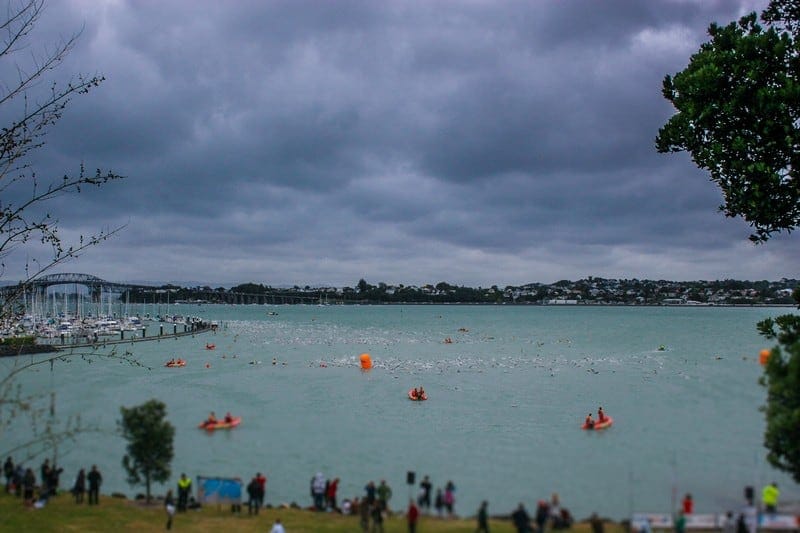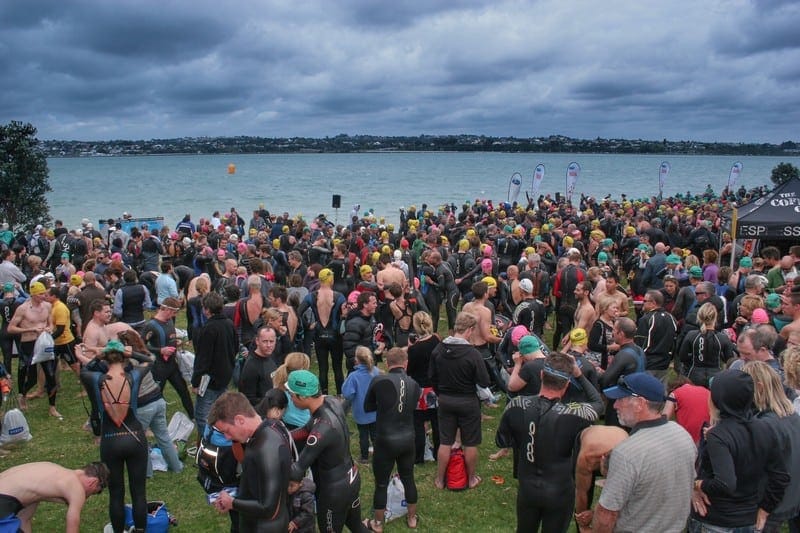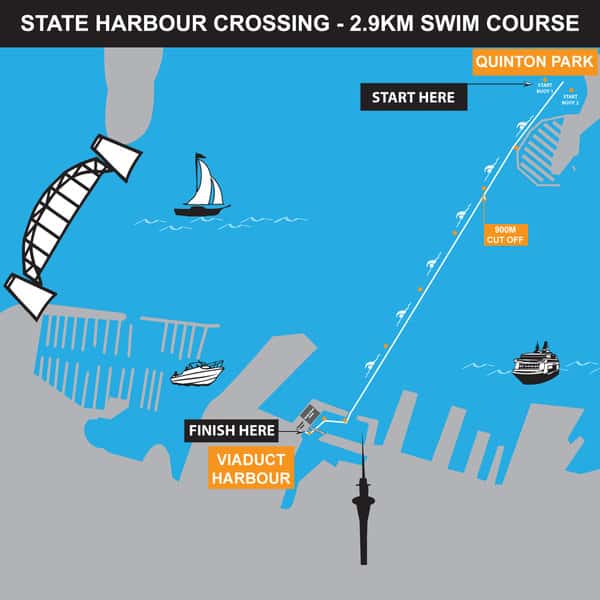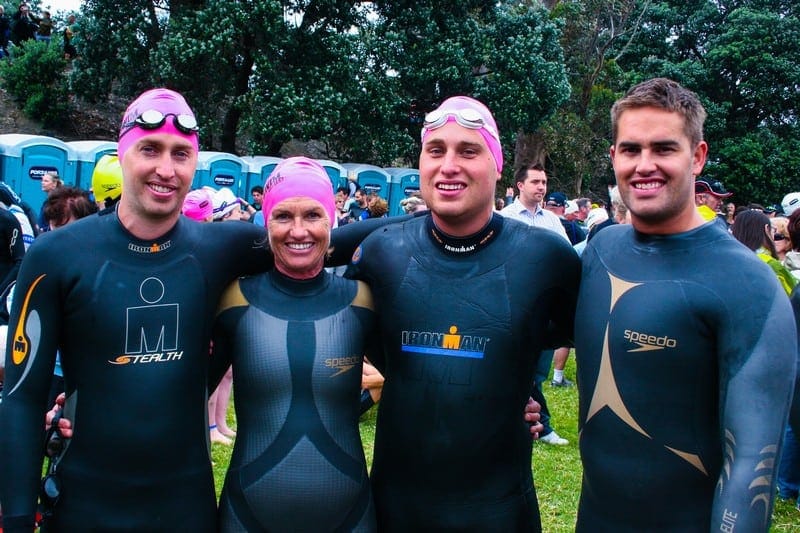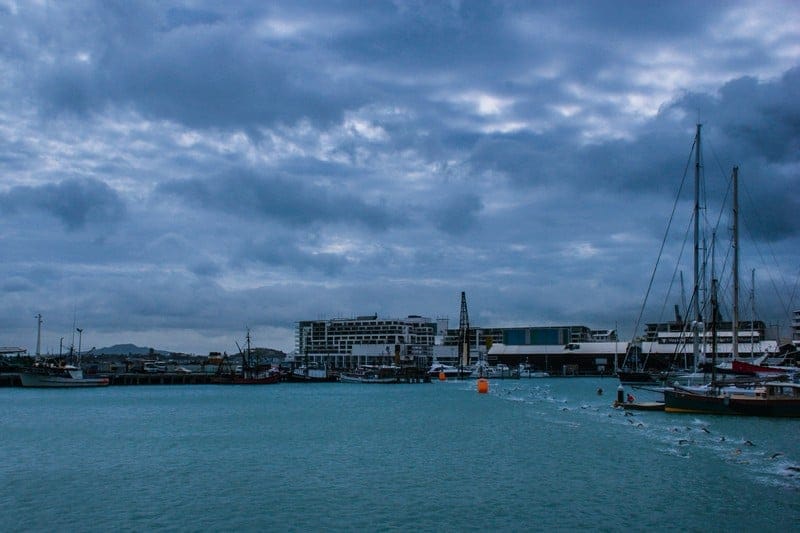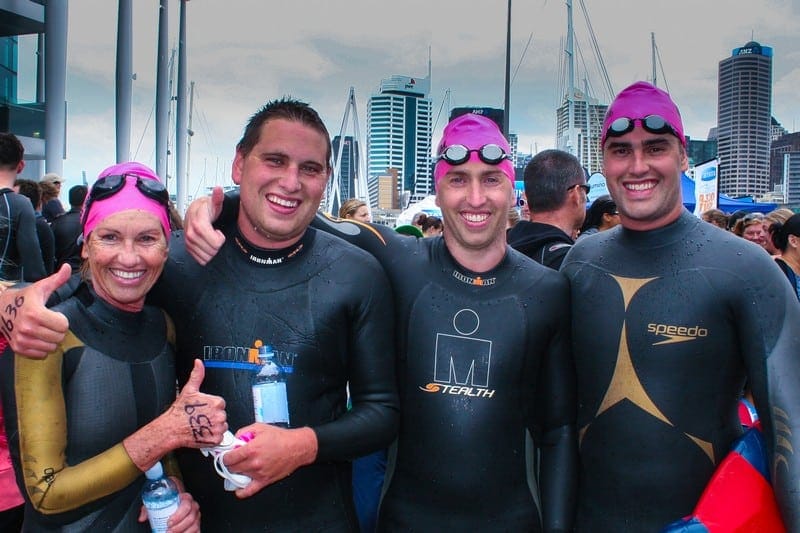Neoprene clad arms flail about me, and not just my own. There are hundreds of them. All fighting atop the frigid ocean. Slowly churning the seawater surface into a white froth that a barista would be proud of.
Green, blue, red and white capped heads bob between the arms. Heads turning and mouths agape gasping for breath between strokes.
Not for the first time I wondered what I had gotten myself into.
Competing in the Auckland Harbour Swim
When most people go on holiday they think about relaxing on a beach sipping a cocktail, or fine dining and experiencing local cultures. So what the hell was I doing lining up to race in the 2.9 km (1.8 miles) Auckland Harbour Swim?
And more so, what the hell was I doing lining up to race in the 2.9 km Auckland Harbour Swim without ANY training!
Auckland Harbour Swim course, 2.9 kms (1.8 miles)
To say I grew up in the water is probably an understatement. Living in New Zealand meant that we were always near the ocean. My family have all represented New Zealand in Underwater Hockey (yes, it is a sport and it is where Adela and I met). My older brother, Moss, even swam in two Olympics and won Gold at the Commonwealth Games.
So I am no stranger to competing in ocean swims. What I am stranger to, is that this was all quite a few years ago.
Mum had convinced my two brothers and I to join her to raise money for depression which she fights on a daily basis. I only had two problems. One being that she had told us that we were doing it 2 weeks before I flew back to New Zealand, and two, that we had no time to train.
Before: Cole, Mum, Dane and Moss, slightly nervous…
Staring out across the course for the Auckland Harbour swim would put most people off attempting it.
Add to that the slow gathering of darkening clouds overhead, heavily laden with rain. The wind howling under the majestic arch of the Auckland Harbour Bridge sweeping the ocean surface into a swarming mess of waves and whitecaps. And even the most sane would decide to back out.
But still the hundreds of the pre-registered swimmers turned up in their droves. Most squeezed into their slick wetsuits with the aid of a little vaseline. Some mad ones choosing to brave it in just a pair of budgie smugglers.
It was only now that apprehension began to seep into the pit of my stomach. The porridge I had consumed at breakfast for its slow releasing energy threatened to release a little quicker from my mouth as my stomach twisted in butterflies and knots.
All too quickly we were ushered into the sea. Barely enough time for a last tightening of goggle straps and hugs all round.
The hooter sounded as we bobbed up and down like corks. The frenzy began.
The starts are always the worst in these events.
Struggling to find a rhythm we stroked away from the line as everyone else took off with blatant disregard for the total distance we had to cover. All thoughts of their own training gone out of their heads as the fight for space ensued.
Boxing Mum in-between us to keep other swimmers out of her path we splashed on. Clawing our way across the Auckland Harbour in a ragged line we followed the marker buoys.
Thoughts rolled uncontrollably through my head.
The salt water spraying from the top off rolling waves quickly dried my throat. Why didn’t I drink more?
Each breath I took increased the raw chafing beginning to burn around my neck where neoprene met skin. Why hadn’t I applied more vaseline?
Weary arms flopped uselessly from my shoulders. Why hadn’t I trained?
Minute after minute we pounded on. Fatigue slowly wearing us down. Yet with each stroke the distant shoreline creeped closer. The rolling waves that had been tossing us about began to subside.
My nostrils filled with the sudden scent of diesel fuel mixed with the ocean. A smell only familiar with moored boats. Through my foggy goggles the outlines of the sun-stained and exposed pilings from the wooden piers plunged into the Auckland Harbour.
Strangers lined the docks cheering us on as if we had just returned from war. Perhaps we had. A war fought against the sea.
A surge of energy flowed through my leaden limbs urging me on.
Blood rushed into our feet as we staggered up the finishing ramp. Legs trembling , barely able to hold my weight. Hands clutched together, grins cracking our weathered faces we stepped across the line.
A moment of triumph.
After: Mum, Dane, Cole and Moss.
If you want to compete in the Auckland Harbour Swim, or any of the six excellent State Ocean Swim Series around New Zealand next summer, check out their website for more information. I highly recommend it. But maybe train a bit more than me first! I would also advise you booking your Auckland travel package in advance, so you get the best deals on your flights and hotel accommodation
Special thanks to all our supporters who donated to our Swim for Depression. We managed to raise $1100!
A huge thank you to the Organiser of the State Ocean Swim Series, Scott Rice, who supported us in the Auckland Harbour Swim. And also Rebecca Barlow for the professional photos taken on the day.
